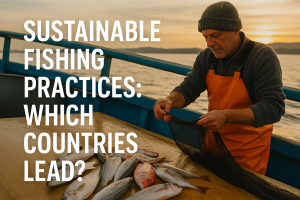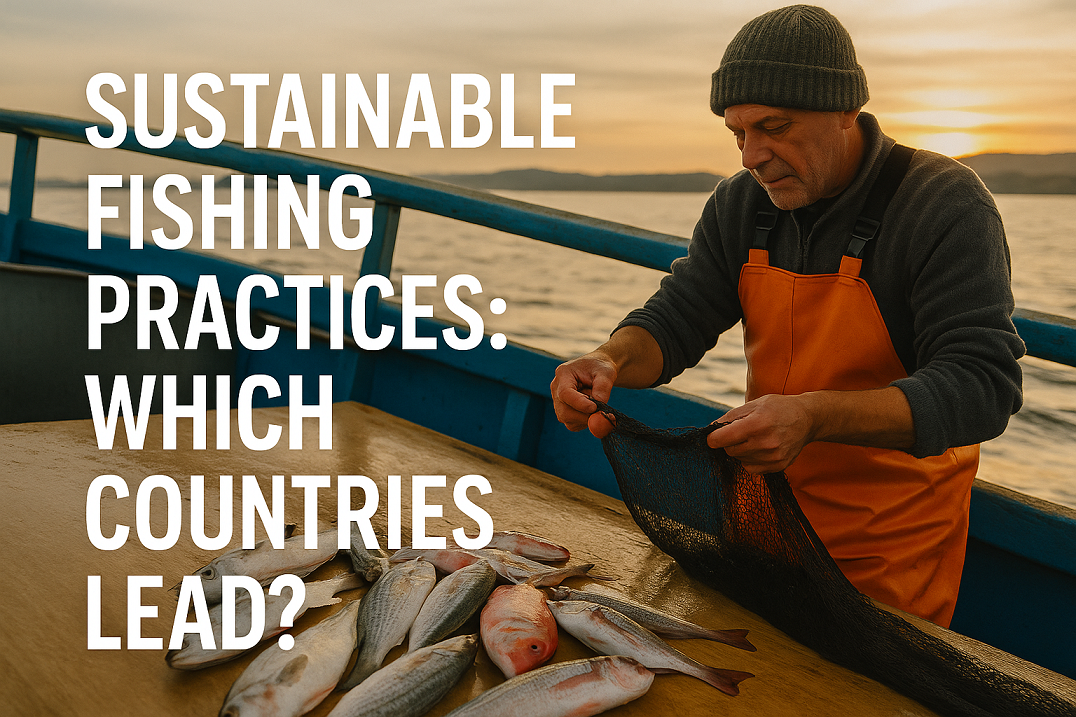Explore how leading nations are shaping the future of our oceans with sustainable fishing practices. Learn who is leading the way, why it matters, and what the future holds for responsible fisheries.”
Why Sustainable Fishing Matters in Modern Maritime Operations
Our oceans are not an infinite resource. Overfishing, bycatch, habitat destruction, and illegal, unreported, and unregulated (IUU) fishing have brought many marine species to the brink. According to the Food and Agriculture Organization (FAO), over 34% of global fish stocks are now classified as overfished. This isn’t just a threat to marine biodiversity—it’s a threat to global food security, livelihoods, and maritime economies.
Sustainable fishing practices aim to balance the needs of today with the needs of tomorrow. By maintaining fish populations, preserving marine habitats, and ensuring fair labor practices, sustainable fisheries support ocean conservation and the long-term viability of the seafood industry.
In modern maritime operations, responsible fishing is not a choice—it’s a mandate shaped by IMO regulations, UN Sustainable Development Goals (SDG 14), and growing consumer demand for traceable, ethical seafood. Countries that lead the way in sustainable fishing practices do so with strong legislation, science-based management, advanced monitoring technologies, and collaboration with local communities and global stakeholders.

Key Strategies and Technologies Driving Sustainable Fisheries
Science-Based Fisheries Management
Leading countries rely heavily on data-driven decision-making. This includes setting Total Allowable Catches (TACs) based on stock assessments, spawning biomass, and seasonal patterns. Nations like Norway and New Zealand work closely with scientific institutions to determine sustainable quotas.
Vessel Monitoring Systems (VMS) and Satellite Tracking
Technologies such as VMS, AIS (Automatic Identification System), and tools from Global Fishing Watch enable real-time tracking of fishing vessels, helping authorities prevent IUU fishing and monitor compliance. For example, Chile and Indonesia have adopted satellite-based monitoring systems to increase transparency.
Bycatch Reduction Technologies
Innovations like turtle excluder devices (TEDs), circle hooks, and selective trawl nets are used to minimize bycatch and reduce harm to non-target species. Australia and the U.S. are notable for enforcing strict bycatch mitigation measures.
Ecosystem-Based Approaches
Ecosystem-based fisheries management (EBFM) recognizes the interconnection between species, habitats, and environmental conditions. Canada’s Fisheries Act (amended 2019) emphasizes habitat protection and ecosystem impacts in fisheries decisions, aligning with this holistic model.
–
Countries Leading the Way in Sustainable Fishing
Norway: The Gold Standard
Norway is globally recognized for its tightly controlled fisheries and science-led management. The Norwegian Directorate of Fisheries and Institute of Marine Research conduct regular stock assessments and enforce individual vessel quotas via an IT-based registration system.
Key achievements:
- Near-complete eradication of IUU fishing in national waters.
- Use of electronic reporting and tracking on all commercial vessels.
- Active involvement in the North East Atlantic Fisheries Commission (NEAFC).
New Zealand: Quota Management and Indigenous Inclusion
New Zealand operates one of the oldest and most successful Quota Management Systems (QMS) in the world. It balances conservation with commercial interests, while also respecting Māori customary fishing rights.
Highlights:
- Legally binding TACs for 638 fish stocks.
- Co-governance with Indigenous communities.
- Continuous ecosystem monitoring via satellite and research partnerships.
Iceland: Catch Control and Eco-Certification
Iceland has developed a highly traceable and transparent fisheries sector, where nearly all marine catches are Marine Stewardship Council (MSC) certified.
Best practices include:
- ITQ (Individual Transferable Quotas) to prevent overcapacity.
- Real-time closures to protect spawning grounds.
- Eco-labeling and blockchain traceability to ensure supply chain integrity.
Canada: Indigenous Knowledge and Legislative Reform
Canada’s modernized Fisheries Act (2019) includes provisions for habitat protection, rebuilding depleted stocks, and integrating Indigenous knowledge.
Key reforms:
- Requirement to rebuild depleted fish populations.
- Funding and support for community-based fisheries and scientific studies.
- Large marine protected areas (MPAs) covering over 14% of marine territory.
Chile: Combating IUU Fishing with Tech
Chile has emerged as a regional leader in the Pacific for its strong anti-IUU strategies.
Progress made:
- Satellite-based Monitoring, Control and Surveillance (MCS) systems.
- Participation in the Port State Measures Agreement (PSMA).
- Public vessel tracking in partnership with Global Fishing Watch.
United States: Enforcing Accountability
The U.S. has one of the most robust fisheries management frameworks under the Magnuson-Stevens Act.
Achievements:
- 47 fish stocks rebuilt since 2000.
- Mandatory use of observers or electronic monitoring on many commercial vessels.
- Science-based fishery management councils across regions.
Indonesia: Transparency in Action
Indonesia has made major strides in fisheries reform with support from international partnerships.
Key initiatives:
- First country to make public its vessel tracking data via Global Fishing Watch.
- Licensing reforms and port inspections to reduce IUU fishing.
- Marine conservation zones integrated with local fishing rights.
–
Challenges and Solutions
Illegal, Unreported, and Unregulated (IUU) Fishing
IUU fishing remains one of the greatest threats to sustainable fisheries. It undermines scientific stock assessments, distorts markets, and encourages human rights abuses.
Solutions:
- Ratification and enforcement of the Port State Measures Agreement.
- Regional coordination through RFMOs (Regional Fisheries Management Organizations).
- Stronger penalties and international cooperation.
Climate Change and Ocean Warming
Rising ocean temperatures are shifting fish distributions and affecting spawning cycles.
Solutions:
- Adaptive management based on environmental indicators.
- Climate-resilient marine protected areas.
- Incorporating climate models into stock assessments.
Economic Pressures and Subsidies
Some governments continue to provide harmful subsidies that promote overfishing.
Solutions:
- Reforms aligned with WTO negotiations to end harmful subsidies.
- Redirecting subsidies toward capacity building and ecosystem restoration.
Future Outlook: What’s Next for Sustainable Fishing?
The next frontier involves integrating AI and machine learning for predictive stock assessments, enhancing electronic monitoring systems, and fostering international trade standards for sustainable seafood. Countries will need to work together more than ever before through platforms like FAO, UNEP, and IMO.
In addition, the push toward blue economy principles—where ocean health is tied directly to economic health—will further solidify sustainable fishing as a core component of maritime governance.
Frequently Asked Questions
What is sustainable fishing? Sustainable fishing means harvesting fish in ways that maintain healthy populations, protect marine ecosystems, and ensure long-term availability of seafood.
How can I know if my seafood is sustainably sourced? Look for eco-labels like the Marine Stewardship Council (MSC) or use apps like Seafood Watch.
Why is bycatch a problem? Bycatch—accidentally catching non-target species—harms marine biodiversity and reduces the population of vulnerable species like turtles and dolphins.
Which country has the most sustainable fisheries? While several countries are leaders, Norway, New Zealand, and Iceland consistently top sustainability rankings due to their strict regulations and advanced technologies.
What can individuals do to support ocean conservation? Consume responsibly, support sustainable brands, advocate for policy changes, and reduce plastic waste.
Are all marine protected areas effective? Not always. The effectiveness of MPAs depends on enforcement, design, and ecological relevance. Fully protected reserves tend to yield better results.
How does climate change affect fishing? It alters fish migration patterns, affects breeding, and increases the risk of stock collapse in sensitive areas.
Conclusion
Sustainable fisheries are not a dream—they are a necessity. From the icy waters of the North Atlantic to the coral reefs of the Indo-Pacific, countries that lead the way show us that balance is possible. With the right mix of science, governance, technology, and community involvement, we can ensure a future where oceans thrive and seafood remains a vital part of human life.
Governments, industries, and individuals must act now. Support responsible fishing, advocate for transparency, and make informed choices. The future of our oceans depends on it.
References
- Food and Agriculture Organization (FAO): https://www.fao.org/fisheries/en/
- Global Fishing Watch: https://globalfishingwatch.org/
- Marine Stewardship Council: https://www.msc.org/
- NOAA Fisheries: https://www.fisheries.noaa.gov/
- New Zealand Ministry for Primary Industries: https://www.mpi.govt.nz/
- Norwegian Directorate of Fisheries: https://www.fiskeridir.no/English
- Fisheries and Oceans Canada: https://www.dfo-mpo.gc.ca/
- UN Sustainable Development Goals: https://sdgs.un.org/goals
- World Bank Blue Economy Report: https://www.worldbank.org/en/topic/oceans-fisheries-and-coastal-economies
- Port State Measures Agreement (FAO): https://www.fao.org/port-state-measures/en/
- Marine Policy Journal (Elsevier): https://www.sciencedirect.com/journal/marine-policy
- Magnuson-Stevens Act: https://www.fisheries.noaa.gov/topic/laws-policies#mag…-stevens-act

